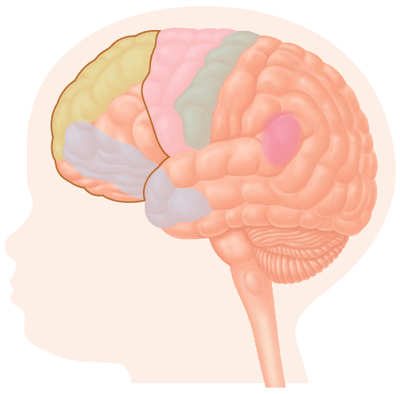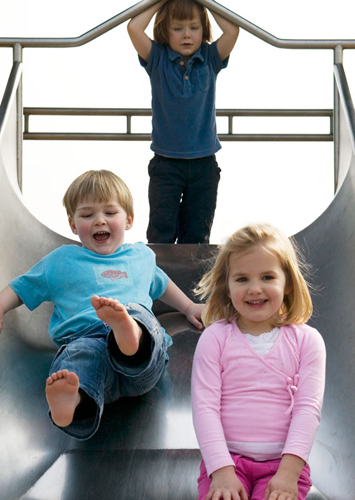The brain development that enabled reasoning skills to evolve during months 24–36
continues this year. As well as learning how to be flexible and
developing memory skills, your toddler also becomes more empathetic and
starts to understand that not everyone sees things the way she does.
“As her imagination begins to develop, she is able to get a sense of how others are thinking and feeling.”
Only from the age of two
onward is the brain sufficiently developed to be able to remember and
recall information, and these skills continue to develop over the next
12 months. Even then, not all information will be remembered easily. We
remember things by recognizing them, and by recalling information about
them.
Your child has been able to
recognize many of the important people in her world since she was two.
This skill develops further now. Recognition is a less complex process
than recalling information and develops much earlier. For example,
Paula, aged 3, can recognize her cousin Hannah when she can see her, but
will find it harder to remember and recall anything about her when she
is not there. Recognition happens via a fast process of comparisons:
“Here is a girl. I will compare her against all my stored memories of
girls. Aha! The girl matches my memory of Hannah.” Accurate recall
depends not only on your child’s reasoning skills (“I know I like
playing with Hannah”), but also on her being able to remember the
context of the information (“because we had fun playing on the swings”).
The frontal lobes play a vital role in tagging memories with this kind of reminder. These
memory “cues” help our recall. (In this case, Hannah is not with her,
but Paula can recall her because the sight of a swing has triggered a
visual memory.) The brain tags and stores information while making sure
that the most useful memories can be retrieved easily when needed.
Social and emotional skills
By the age of three, your
toddler will be starting to discover that other people may think and
feel differently than the way she does. (“Mommy does not always know
what I want. Sometimes I have to tell her.”) This shows in a toddler’s
impulse to comfort another child who is upset. Over the next year,
reasoning skills will develop so that, for example, Cara will not only
understand that “Tommy is upset, don’t cry” but that “Tommy is upset
because…” and will start to modify her behavior accordingly. This
ability to empathize is vital in being able to recognize and respond
sensitively to the reactions and behavior of others.
However, the ability
to feel empathy cannot develop fully until the frontal lobes have begun
to mature. Your child will gradually become more consistently
understanding and you will notice that she begins to play more
cooperatively, showing that she has expanded her emotional range and
understanding. This early breakthrough shows she is well on her way
toward developing rewarding relationships in later life.
All the functions of
the frontal brain develop together and each is dependent on another; so
your toddler won’t be able to understand her friend’s feelings or be
able to see life from her perspective, until she can pay attention for
long enough to read her reactions and be able to recall and understand
them. As memory builds over time, so will your child’s sensitivity and
understanding of the wider world and the people in it.
Development is
rarely a steady line of forward progress. Under stress (having a
tantrum, being asked to share a toy, a new sibling being born) it is
possible that a child will revert back to being more egocentric and will
abandon some of her compassionate skills. It is usual for skills to
fluctuate in this way as they develop and become more established.
Social and emotional understanding
As the frontal lobes mature, individual personality and social
behavior develop alongside more sophisticated thinking and reasoning
skills.

Learning and flexibility
Doing or thinking about
more than one thing at a time is a challenge for toddlers, who tend to
be quite fixed and rigid in their approach. For example, Annie isn’t
able to consider that her red crayon can easily replace her blue crayon.
She might even get upset if anyone suggests it. In time and with
encouragement, Annie will be able to become more flexible and will learn
to choose an alternative option. “I want the blue one, and I want it
now!” will gradually become, “I wanted the blue one, but it’s not here,
so the red one will do just as well for now.” The thinking and reasoning
part of her brain allows this more flexible approach.
Learning about Gender
Until now, your
toddler was almost unaware of whether she was a girl or a boy. She may
have been told she was a “girl,” but would not have understood what it
meant, and may not have been able to recognize the differences between
boys and girls.
“Knowing that ‘I am a boy’
or ‘I am a girl’ helps a child to develop a sense of identity and
understand where he or she fits in with the world. These differences
help children learn how to behave.”
Between the ages of
3–4, your child will become more aware of the differences between being
male and female from her experiences at home, her broader environment,
and via other children. Now that traditional male and female roles have
become blurred, children have a more flexible interpretation of mommies’
and daddies’ roles, but this does not appear to affect their
understanding of what it is to be a boy or a girl.
The differences
between girls and boys are surprisingly small during the toddler years.
Hormonal differences and differences in brain development may explain
the tendency for some boys to enjoy more aggressive and active play and
some girls to be more chatty and “girly.”
Generally speaking,
however, childhood roles are fairly interchangeable. There is no need to
worry or prejudge the situation if you find your son loves dressing up
or playing with dolls, or your daughter is most at home “playing
soldiers.”
Children tend to be
attracted to the toys and games that offer the most excitement or that
have the most sparkle and glitter. Some boys will prefer to play more
gentle games and some girls will prefer to play rough, but this is just a
part of who they are, and they will be influenced by what Mommy or
Daddy enjoy when they are relaxing and playing, too.
We’re different
Children begin to realize some playmates are boys and some girls,
and may begin to ask direct questions about their differences.

How differences develop
Social
influences play the most important part in helping children learn male
and female roles in life. Parents, caregivers, and other children will
reinforce male and female roles and behavior. The process starts from
the moment children are born with what color you painted your baby’s
room, and what color clothes you bought.
Some of the messages
we give our children are subtle and subconscious, and start very young
(for example, “pink for a girl and blue for a boy”). Others are more
obvious and may come out through play: “Let’s play tea party with your
dollies, Jessica,” versus “Let’s play soccer in the park, Rob.” Often
these messages reinforce the innate differences between the sexes. For
example, we offer boys more active toys and more rough-and-tumble play,
while social play and talking may be the domain of girls. This will be
due to a combination of feedback from your child—doing what he or she
likes doing, and what you most value—what you think little boys and
little girls should be doing. There is nothing wrong with this. Boys and
girls are different (although there are shades of male and female
characteristics in all individuals). Our ideas about gender and behavior
are influenced by our culture. Society’s norms affect the way we
behave, our beliefs, and how we organize our lives.
Exploring differences
During this year
children may start to show a preference for gender-related toys and have
more interest in friends of the same sex. They may start to judge each
other: “boys, yuk” or “girls, silly,” and do some personal exploring.
Pretending to be a princess or a fireman is a normal and healthy part of
development and a way for your child to explore boy-girl differences.
Do what you can to allow
your child to lead in her choices and try not to judge. Comments such as
“Big boys don’t cry”/“Tom, help Daddy in the garage”/“Mary, help Mommy
get the lunch” will reinforce traditional roles.
There is a tendency to
talk more to girls about feelings and more to boys about how to figure
things out. The healthy approach is to give both genders the same toys
and opportunities while acknowledging that differences between boys and
girls do exist.
Real life
Hanif is closest in age
to his sister Rana, who loves all things pink and fluffy. As a result,
Hanif has learned to enjoy “girly” games and is just as happy wearing
his sister’s princess costume as he is playing with his toy cars or
learning to climb. “We don’t worry,” says his Dad, Raj. “They are just
having fun! He has a fabulous imagination and they both enjoy
play-acting. It will be interesting to see how their tastes change and
develop as they get older and when Hanif meets new playmates at school.”